Chapter 5. Additive Color Mixtures and Primary Colors
5.1 Title slide
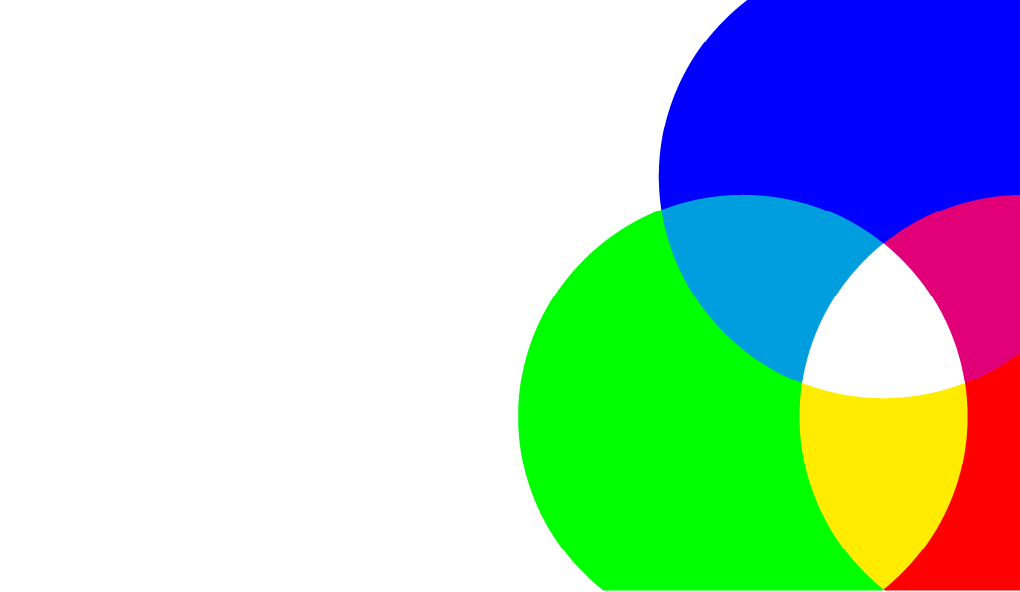
Additive Color
Mixtures and
Primary Colors
Adjust the relative amounts of red, green, and blue light in additive color mixtures to see how that affects the color of the mixtures.
CLICK ANYWHERE TO BEGIN
What Is an Additive Color Mixture, and What Are Primary Colors?
Consider what happens when a red light, a green light, and a blue light are projected on a white screen so they partially overlap (see Figure 1). The screen equally reflects all the wavelengths that hit it, because the reflectance of a white surface is much the same at every wavelength. Thus, the proportions of wavelengths in the reflected light are the same as the proportions in the projected lights, and where the lights overlap, the reflected light contains the sum of the wavelengths in the overlapping region. This is called an additive color mixture because it results from adding wavelengths.
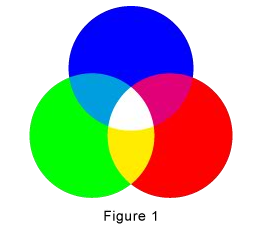
The triangle formed in a color circle by connecting any three colors encloses a range of other colors that can be created by combining lights of those three colors in different proportions (see Figure 2). Any three colors connected in this way are called primary colors. Some sets of primary colors are better than others, in terms of producing as many of the colors in the color circle as possible. The triangle formed by red, green, and blue (the white triangle in Figure 2), for example, has as large an area as a triangle in the color circle can have, so it encloses as large a range of other colors as possible. However, these three primaries are incapable of producing a highly saturated magenta, cyan, or yellow, which are outside the triangle. Magenta, cyan, and yellow also form as large a triangle as possible (the black triangle in Figure 2), but are incapable of producing a highly saturated red, green, or blue.
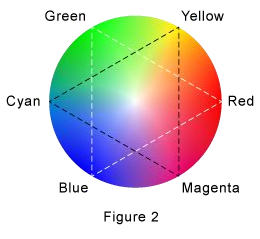
5.2 Explain - dnd
Red, green, and blue constitute a set of primary colors: they can be mixed in different proportions to produce a wide range of other colors.
Drag the sliders to adjust the intensity of each light and see how that affects the colors of the additive mixtures.
5.3 Explain
What Is an Additive Color Mixture, and What Are Primary Colors?
Consider what happens when a red light, a green light, and a blue light are projected on a white screen so they partially overlap (see Figure 1). The screen equally reflects all the wavelengths that hit it, because the reflectance of a white surface is much the same at every wavelength. Thus, the proportions of wavelengths in the reflected light are the same as the proportions in the projected lights, and where the lights overlap, the reflected light contains the sum of the wavelengths in the overlapping region. This is called an additive color mixture because it results from adding wavelengths.
The triangle formed in a color circle by connecting any three colors encloses a range of other colors that can be created by combining lights of those three colors in different proportions (see Figure 2). Any three colors connected in this way are called primary colors. Some sets of primary colors are better than others, in terms of producing as many of the colors in the color circle as possible. The triangle formed by red, green, and blue (the white triangle in Figure 2), for example, has as large an area as a triangle in the color circle can have, so it encloses as large a range of other colors as possible. However, these three primaries are incapable of producing a highly saturated magenta, cyan, or yellow, which are outside the triangle. Magenta, cyan, and yellow also form as large a triangle as possible (the black triangle in Figure 2), but are incapable of producing a highly saturated red, green, or blue.
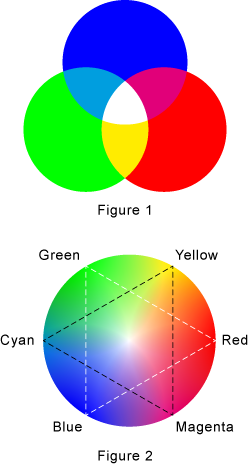
5.4 Test - single choice
Select your answer to the question below. Then click SUBMIT.
A light is monochromatic if it consists of a single wavelength. Which wavelengths are contained in a mixture of monochromatic light?
The correct answer is A. Click EXPLAIN if you want to review this topic.
5.5 Test - single choice
Select your answer to the question below. Then click SUBMIT.
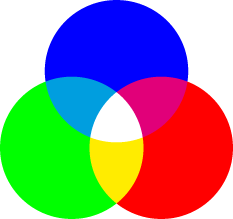
What color would the white area be if one of the spots of light were turned off?
The correct answer is C. Click EXPLAIN if you want to review this topic.
5.6 Test - single choice
Select your answer to the question below. Then click SUBMIT.
In the illustration, colors A–B–C are a set of primary colors, and so are colors D–E–F. Which of the numbered regions represent colors that can be produced by mixing lights A–B–C, which represent colors that can be produced by mixing lights D–E–F, which represent colors that can be produced by mixing either set, and which represent colors that can’t be produced by mixing either set?
The correct answer is B. Click EXPLAIN if you want to review this topic.

5.7 Activity completed
Additive Color Mixtures and Primary Colors.